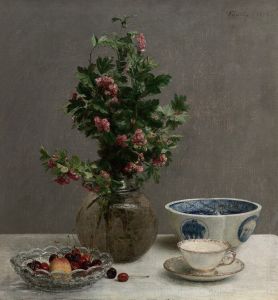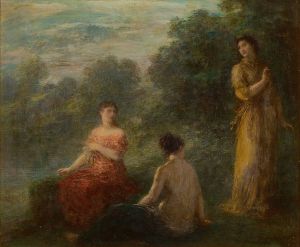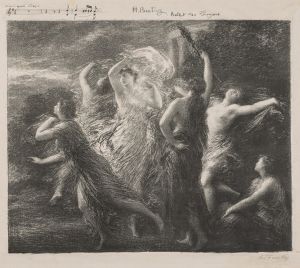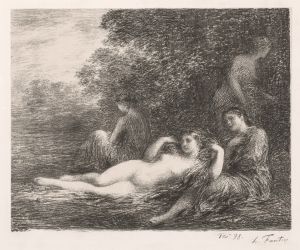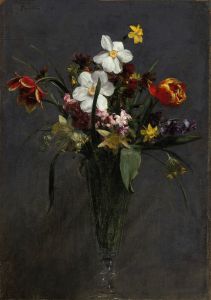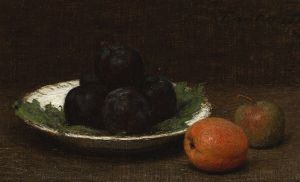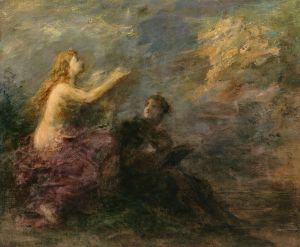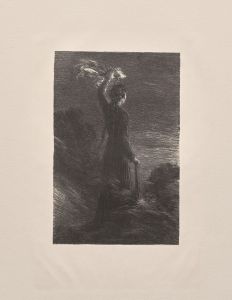
Pêches et prunes
A hand-painted replica of Henri Fantin-Latour’s masterpiece Pêches et prunes, meticulously crafted by professional artists to capture the true essence of the original. Each piece is created with museum-quality canvas and rare mineral pigments, carefully painted by experienced artists with delicate brushstrokes and rich, layered colors to perfectly recreate the texture of the original artwork. Unlike machine-printed reproductions, this hand-painted version brings the painting to life, infused with the artist’s emotions and skill in every stroke. Whether for personal collection or home decoration, it instantly elevates the artistic atmosphere of any space.
Henri Fantin-Latour, a renowned French painter, is celebrated for his exquisite still life paintings and portraits. Among his notable works is "Pêches et prunes," a still life painting that exemplifies his mastery in capturing the delicate beauty of everyday objects. Fantin-Latour was born on January 14, 1836, in Grenoble, France, and he developed a keen interest in art from a young age. He studied at the École des Beaux-Arts in Paris and was influenced by the works of the Old Masters, which is evident in his meticulous attention to detail and composition.
"Pêches et prunes" is a testament to Fantin-Latour's skill in still life painting, a genre that he excelled in throughout his career. The painting features a simple yet elegant arrangement of peaches and plums, rendered with a remarkable sense of realism. Fantin-Latour's ability to depict the textures and colors of the fruit with such precision is a hallmark of his style. The composition is carefully balanced, with the fruits arranged in a harmonious manner that draws the viewer's eye across the canvas.
Fantin-Latour's still lifes are characterized by their subtle use of color and light, and "Pêches et prunes" is no exception. The soft, natural lighting in the painting enhances the rich hues of the peaches and plums, creating a sense of depth and dimension. The background is typically understated, allowing the viewer to focus entirely on the subject matter. This approach reflects Fantin-Latour's belief in the importance of simplicity and clarity in art.
Throughout his career, Fantin-Latour maintained a strong connection to the traditions of still life painting, while also incorporating elements of modernity. His works were highly regarded by his contemporaries, and he exhibited regularly at the Salon in Paris. Despite the rise of Impressionism during his lifetime, Fantin-Latour remained committed to his own artistic vision, which was rooted in realism and classical techniques.
Fantin-Latour's still lifes, including "Pêches et prunes," were particularly popular in England, where they were admired for their technical precision and beauty. His works were collected by prominent figures and institutions, contributing to his international reputation. Today, Fantin-Latour's paintings can be found in major museums and galleries around the world, where they continue to be appreciated for their timeless elegance and craftsmanship.
In addition to his still lifes, Fantin-Latour was also known for his portraits and imaginative compositions. He was friends with several leading artists and musicians of his time, including Édouard Manet and Richard Wagner, and he often depicted them in his works. Despite his success, Fantin-Latour remained a somewhat private individual, dedicated to his art and the pursuit of perfection in his work.
Henri Fantin-Latour passed away on August 25, 1904, in Buré, France, leaving behind a legacy of paintings that continue to captivate audiences with their beauty and technical brilliance. "Pêches et prunes" remains a fine example of his contribution to the art of still life, showcasing his ability to transform simple subjects into works of profound beauty and elegance.





